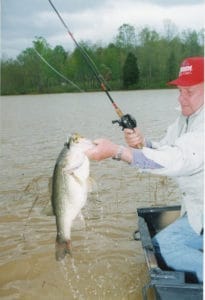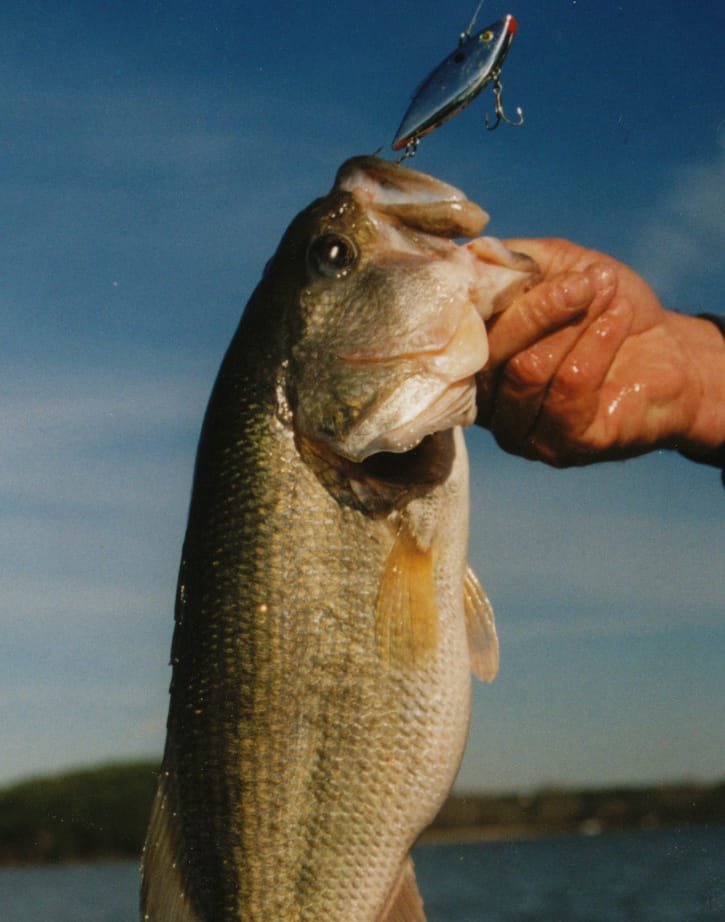by Beau Tallent
I love all types of fishing, from deep-sea bottom fishing to high-mountain fly rodding. Give me a farm pond that’s home to a few bass, put me in a low-sided jon boat, and hand me a sculling paddle. I’m in my fishing heaven.

Farm ponds provide a perfect, relaxing setting for a day of fishing. And the bass catching can be phenomenal!
The attractions to a farm pond or small lake are many, not the least of which is a very peaceful, relaxing setting. Daybreak on a secluded farm pond is good for the soul, and it could make a lifetime angler and outdoors lover out of the most jaded of city slickers. Bass breaking the surface at daybreak of a farm pond—that’s just magical.
The reason I love farm pond bass fishing the best? I love catching bass. Farm ponds—even those that aren’t slam-dunk lakes teeming with bass—can provide great action. Small-lake bass are hemmed up, and the bass catching is even better if you have a plan of attack for a small body of water.
The Dock
Most farm ponds and small lakes have a dock. Many of these docks are in rough shape—half fallen in, and they might even have a bush or other growth sprouting up through the wooden slats. The older the dock the better has been my experience.
This most obvious piece of farm-pond structure is often the most overlooked. Or, at least, it’s often attacked incorrectly. I’d venture to bet most anglers, when they arrive at the lake’s edge to fish a farm pond, begin by walking out on the dock and stacking up gear before loading up the jon boat and pushing off to begin the day of fishing. Those anglers just spooked any bass that call that dock their living room, and in a small pond, those bass probably included the biggest bass in the lake. When the anglers come back by the dock an hour or two later and fish it, a dink or two is all they might muster.
Ease down to the dock like you’re stalking a big buck, and fish it from the bank. Run a topwater along the sides, and then work the dock posts with a Texas-rigged lizard. If you don’t get a bite, you might consider finding a new farm pond to fish because the dock should be a sure thing for a bass or two.
First Light Topwater
The reason most anglers make a bunch of noise scaring bass away from the dock is because at daybreak they hear bass breaking the surface somewhere down the bank. Understandably, everyone is in a hurry to get after those bass, and for good reason. Especially in the heat of summer, that topwater bite won’t last long. When the sun hits the water, it’s typically over.
Here’s how we attack the awesome, albeit time-limited morning topwater bite. Whether you’re in a boat or fishing from the bank, make casts as close and parallel to the bank as possible. You want to cover water quickly. Try to pick off as many active bass feeding in the shallows as possible before the sun hits the water. A buzzbait is a great lure for this technique. When pond fishing, I prefer a soft “bubbler” buzzbait rather than a loud, clacker-style bait. A white or chartreuse 3/16-oz. Strike King Tri-Wing Buzz King or similar style buzzbait works well in farm ponds, where shallow bass can be more skittish than in a big-water, reservoir-type situation where wave action and noise are common.
If a bass swipes at your buzzbait and misses, or if you’re in an area where a bass has been active in the shallows but isn’t interested in the buzzbait, try a Bang-O-Lure with a rear prop. This bait, for whatever reason, is a big-bass magnet, especially on small lakes. Twitch the Bang-O-Lure so the rear prop throws some water over the bait, and then let it sit for as long as you stand it. Another good option is a Pop-R, a small bait that also has a subtle topwater presence. The Bang-O-Lure is a big-bass bait, while the Pop-R is usually better for numbers.
The Dam Corners
Once the sun hits the water, those easy bass slamming topwater in the shallows often evaporate. My next target is the corners of the pond dam. I’ll make sure to fish these two spots before the sun gets high and the temperatures really begin to climb. A bass angler older and wiser than me started me on fishing dam corners, and I remember asking him why this is almost a sure-thing on most farm ponds. His theory was that aggressive bass in a small lake often move shallow to feed, and they then cruise the bank. The pond corners are like a busy intersection, he theorized.
A dam corner usually has good flat that drops off into some of the deepest water in the pond. If there are good flats, both corners will usually have bream beds during the summer. Run a spinnerbait through these areas, especially around the full-moon period when bluegills are bedding. You can also ply the edges of these flats and drop-offs with a Texas-rigged lizard or worm. I’ve found that a Zoom Super Salt Plus lizard in pumpkinseed or green-pumpkin colors is hard to beat.
Open-Water Fan Cast
Bank cover gets most of a bass angler’s attention, especially in a farm pond. But some number of bass are usually going to be off the banks, either loafing or cruising the open water in the middle of a small lake. These bass might not be actively feeding, but a reaction bait can often draw a strike.

The bass in most small lakes can’t resist a Rat-L-Trap. Try moving out to the middle and fan casting with this lipless crankbait.
A technique that often produces some additional bass when we fish a small lake is to move out to the middle and fan cast with a crankbait. For this, I love a Rat-L-Trap. I use the old standard, a ½-oz. Trap in the chrome-with-a-black-back color. You can cast this lipless crankbait a country mile, and bass love it, especially bass in a farm pond where fishing pressure is light.
When fan casting a Rat-L-Trap, I usually start with a fast retrieve. I make a long cast, let it sink about halfway to the bottom, and then I burn it back to the boat. I’ll quickly work the open water all the way around the boat. Then, from the same spot, I’ll try a stop-and-go retrieve with the Trap.
Finally, I’ll let the lure sink to the bottom and use a pump-and-fall retrieve, sweeping the rod and reeling up the slack while letting it fall back to the bottom. Cover all of the deeper, open water away from the bank with a Rat-L-Trap or your favorite crankbait.
Dissect a farm pond or small lake with these techniques, and more often than not you’re going to leave with a roughed up thumb from lipping largemouth bass.
The Union Sportsmen’s Alliance website is designed to provide valuable articles about hunting, fishing and conservation for members of AFL-CIO affiliated labor unions and all sportsmen and sportswomen who appreciate hunting and fishing and want to preserve our outdoor heritage for future generations. If you would like your own story and experience from the outdoors to be considered for our website, please email us at [email protected].



